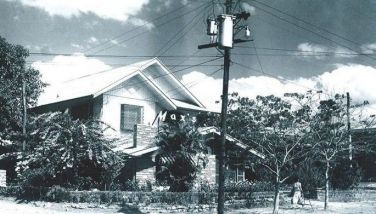Reflections on EDCA
Since 1898, there have been US forces stationed in the Philippines either as conqueror, administrator or ally. Except for three-and-a-half years of Japanese occupation and six years following the Senate vote that closed the bases, GI Joe has been around, friendly and fun-loving, leaving us with some of our best basketball players.
Not many Filipinos know that the United States wanted the Philippines so badly. After defeating the Spaniards in the Spanish-American War, that included the destruction of the Spanish armada in the Battle of Manila Bay in May 1898, they agreed to pay Spain $20 million to let go of the Philippines when, as victors in war, everything was theirs for the taking. No other conflict in history ended with similar arrangements between the victor and the vanquished.
Fast forward to 1951. In August 1951, the Philippines and the United States signed a Mutual Defense Treaty that called for both nations to support each other in the face of external attacks. In 1992, US forces left the Philippines due to the closure of the bases but six years later in 1998, a new agreement was reached between the two countries. The new arrangement, called “The Visiting Forces Agreement (VFA),” allowed the stationing of US forces in the Philippines on a rotational basis under certain procedural requirements. The VFA allowed the United States to retain jurisdiction of US military personnel accused of committing crimes in the Philippines, unless the crimes were “of particular importance to the Philippines.”
Fifteen years later a supplemental agreement to the VFA was signed by Defense Secretary Voltaire Gazmin and US Ambassador Philip Goldberg in April 2014. The Enhanced Defense Cooperation Agreement (EDCA) allowed the United States to rotate troops into the Philippines for extended stays and also allows the United States to build, operate facilities in Philippine military bases and to pre-position equipment, aircraft and vessels in these facilities. A ranking US national security official described EDCA as “the most significant defense agreement concluded with the Philippines in decades.” In 2016, the Philippine Supreme Court ruled with finality that the agreement was constitutional. While the United States asked for eight sites, agreement was reached for only five.
Incidentally, there appears a need for more information dissemination on the meaning of EDCA. Some folks are under the impression that EDCA is an educational program designed to recover lost ground in English and Math, that showed the Philippines at the bottom among other countries included in the testing. One individual I asked was completely clueless, saying she does not read the newspapers and relies mainly on social media for any new or interesting developments.
Of the five sites, four are Air Force facilities and one is Army. For the enhancement of these chosen locations, an initial allocation of $82 million was granted by the US government under EDCA.
Fort Ramon Magsaysay is the largest military reservation in the Philippines. It straddles the provinces of Nueva Ecija and Aurora, and originally covered 73,000 hectares but this has since been cut down to only 35,000, possibly even less today. It is the key training area for the AFP and visiting US forces, and is home to the 7th Infantry Division headed by Maj. General Andres Costello.
Basa Air Base in Floridablanca, Pampanga is the major operating base of the Philippine Air Force 5th Fighter Wing, led by Brig. General Leo Fontanilla. Recently, US Air Force Secretary Frank Kendall was the guest of honor at the continuing rehabilitation of the base runway, possibly the most important project in the area. The rehabilitation consists of upgrading and repairing portions that were in a state of deterioration. The project costing $25 million is one of the biggest under EDCA, and is expected to be completed this August. Basa Air Base is named after Lt. Cesar Tianko Basa, the first Filipino fighter pilot casualty of World War II.
The Antonio Bautista Air Base in Puerto Princesa, Palawan is our closest airfield covering the West Philippine Sea. It is named after Lt. Colonel Antonio Marfori Bautista, who perished in a support mission against rebels in Parang, Jolo. Tactical operations are under the command of Brig. General Erick Escarcha.
Benito Ebuen Air Base in Mactan, Cebu is named after the third PAF commanding general who died in the crash of the presidential aircraft with President Ramon Magsaysay in 1957 on the slopes of Mt. Manunggal, Cebu. Known in the past as Mactan Air Base, it was used as a transit point for US aircraft during the Vietnam War. Operations in the base are handled by Brig. General Ramil Oloroso.
Lumbia Airport in Cagayan de Oro is the last of the Air Force sites to be developed under EDCA. A tactical operations group headed Lt. Colonel Harold Fernando is stationed at Lumbia.
There are continuing reports that four more sites will be designated for US use under EDCA. Cagayan and Isabela are among the provinces mentioned. Last week, two US patrol ships, both almost 30 years old and designed for shallow water operations, were decommissioned in Bahrain for transfer to the Philippine Navy.
* * *
But wait! Two weeks ago, I came across a CNN report by Michelle Toh: “Dozens of American companies are in Vietnam this week in hopes of pushing further into the fast-growing Southeast Asian economy which has emerged as an attractive potential alternative to China, as companies seek to diversify their markets and supply chains. Senior executives from 52 US firms are taking part in the biggest business mission ever organized by the US-ASEAN Business Council. The trip held annually is led by former US ambassador to Vietnam, Ted Osius… The Council did not specify who was attending but corporate heavyweights Boeing and Netflix confirmed they had joined the delegation.”
We are good for bases, not for business!
- Latest
- Trending






















